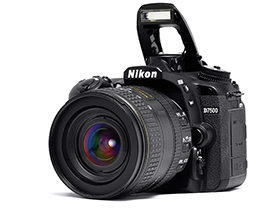 Performance
Performance
The D7500 focussed reasonably fast with the AF-S Nikkor 16-80mm VR lens that was provided by Nikon. Live View focussing has been greatly improved and touch focus was snappy. Metering was as expected.
The camera delivered 7.5 frames per second in continuous mode for JPEG Large and Fine* images, and continued to capture 100 frames before slowing down. The device took 51 sec to write these images to the card (We used a Sandisk Extreme PRO U3 card for the test). The 7500 shot Raw + JPEG simultaneously at 7 fps up to 35 frames and this time, the camera took over 27 sec to write these images to the card. The buffer clearly shows an improvement over the D7200.
The D7500 provides 4 extra stops of expanded sensitivity over the D7200. At 25 percent of the screen size, the images were free of noise till ISO 3200 and could be used till ISO 6400. Enlarged to 50 percent, noise started showing up from ISO 3200, getting into the disturbing level from ISO 12,800 onwards. Viewed at 100 percent screen size, the images were usable up to ISO 800, though ideally, we would advice you to stick to ISO 400 or below. Noise became quite disturbing from ISO 6400. Then, you may ask, why they incorporate such high expanded ISO sensitivities if it does not provide the required advantage? The answer probably lies in video capture and lowresolution modes, where the captured footage/frame is down-sampled and hence noise becomes less evident. While the noise levels have greatly reduced at low ISOs, we observed significant noise at high sensitivities.
The camera captured colours true to the scene in Auto White Balance, except under incandescent light, where it produced slight warm cast. However, we wouldn’t consider this a problem since the camera provides an option to finetune White Balance. Videos were punchy and smooth, but we felt the need of a video-optimised lens so that the device does not pick-up the operating sound.
Value for Money
The D7500 retails at an MRP of Rs. 115,450 along with the AF-S Nikkor 18- 105mm VR lens. The body carries a price tag of Rs. 96,950, which is Rs.25,000 more than the D7200. Considering the features trickled down from the D500, we would consider this competitive pricing. |SP
FINAL SCORE 82%
Design and Build Quality 16/20
Key Features 17/20
Ergonomics 16/20
Performance
Autofocus 4/5
Metering 5/5
Noise Control 3/5
Sharpness 4/5
LCD/EVF 4/5
Auto WB 5/5
Sub-Total 25/30
Value for Money 8/10
PLUS
• 8fps continuous speed
• Increased buffer
• 4K video capability
• Group area focus
• Improved Live View shooting
• Improved AF and tracking
• Tilting LCD
MINUS
• Lower resolution than D7200
• Single memory card slot
• Not compatible with UHS-II cards
• No magnesium alloy body
• AI, AI-S lenses will not meter
VERDICT
Like the world out there, we were also excitedly waiting for this camera with features adopted from the D500. And after handling it for some time, we are left wondering whether the D7500 is really an upgrade or a ‘re-arranged’ D7200. The camera surely gets a 2-fps boost in continuous shooting, 4K video, tilting LCD and, theoretically, an expanded ISO range to brag about. But all these come at the expense of 3 million pixels, one memory card slot, and the confidence provided by a magnesium alloy body. The reduction in resolution, by itself, must have improved the continuous shooting rate, and the expanded ISO range does not appear too impressive, considering that the camera uses the latest image processor. And while others have managed to reduce the size of their D-SLRs considerably, the APS-C D7500 is approximately the same size and weight that of the full frame Canon 6D. The D7500 has done away with mechanical aperture tabs and hence older AI and AI-S lenses will not meter with the camera. If Nikon intends to replace the 7200, we are not thoroughly impressed. But if it is going to be placed between the D7200 and the D500, we appreciate it. Nevertheless, the fact that this camera brings its flagship’s features down to an enthusiast camera still makes it a Best Buy.
Sujith Gopinath


